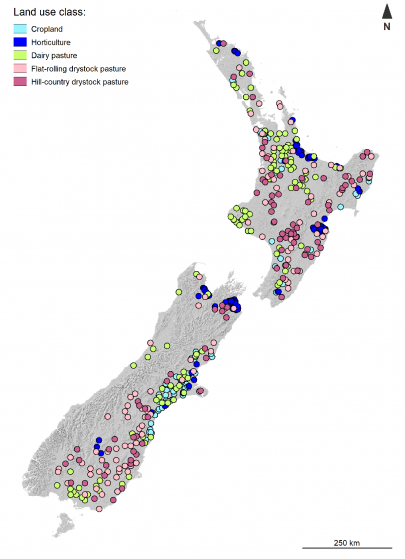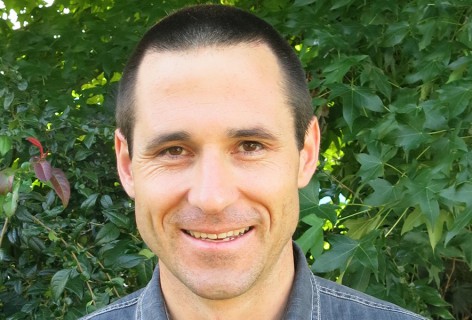An update on the national soil carbon benchmarking and monitoring system for agricultural land in New Zealand

Figure 1: Location of 500 sites on agricultural land for soil organic carbon monitoring in New Zealand. Internal lines are Regional Council boundaries. Coloured dots are different land-use classes.
National-scale changes of SOC stocks in mineral soils are currently predicted based on transitions of land use (e.g. forest to pasture) using a statistical model calibrated with historical data. The model assumes that SOC doesn’t change if there isn’t a change in land use (e.g. if an area remains in long-term pasture). Recent work showed that between 1990 and 2016, around 92 percent of the total land area of New Zealand remained within the same land-use, and hence no changes in SOC could be inferred for this area. However, there are limited data from direct measurements of SOC change through time to test this, and what data we do have were often collected for purposes other than specific SOC monitoring and are not fully representative of New Zealand’s agricultural land.
The new national SOC benchmarking and monitoring system, funded through the New Zealand Agricultural Greenhouse Gas Research Centre is making good progress on benchmarking soil carbon stocks at 500 sites across agricultural land in New Zealand (Figure 1). Samples are collected in 10-cm increments to 60-cm depth using soil cores, or quantitative pits for stony soils. About 100 sites will be sampled in each of five broad land use classes (Figure 1), with the main purpose of the project being to monitor change in SOC stocks through time within each land use class.
As of June 2022, 275 of the 500 sites have been sampled, with sampling of remaining sites ongoing. Initial estimates of the SOC stocks within each land use class have been made – on average, the highest SOC stocks are in soils under dairy pasture and the lowest under cropping land. However, these results must be treated with caution. More, or less, SOC cannot be interpreted as a land-use effect because the location of different land uses is often related to soil type and climate in the first place. For example, there are proportionally more dairy sites on Allophanic soils, which have naturally high SOC stocks, due to the soil’s specific mineralogy.
When benchmark sampling of all 500 sites has been completed in 2023, further inferences about the effect of some key land use/soil order interactions on SOC stocks should be possible, particularly within grassland classes. However, the key longer-term focus of this study is to determine whether SOC stocks are changing through time within different land use classes, and the answer to this question will be obtained after resampling the sites. The plan is to begin resampling sites in 2023 (benchmark sampling started in 2018).
Our results will provide greater certainty about SOC stocks and stock changes in New Zealand and will be used to improve national greenhouse gas inventory reporting. Robust data for different land uses will also help enable the primary industry to make credible statements about SOC to international markets amid increasing emphasis on good environmental stewardship. Information from direct measurement of changes in SOC stocks under different land uses (in New Zealand conditions) will assist farmers as they consider options for reducing their net GHG emissions at the farm scale.
This article was originally published in Pūtaiao: Manaaki Whenua science summary / ISSUE 11 / AUGUST 2022
